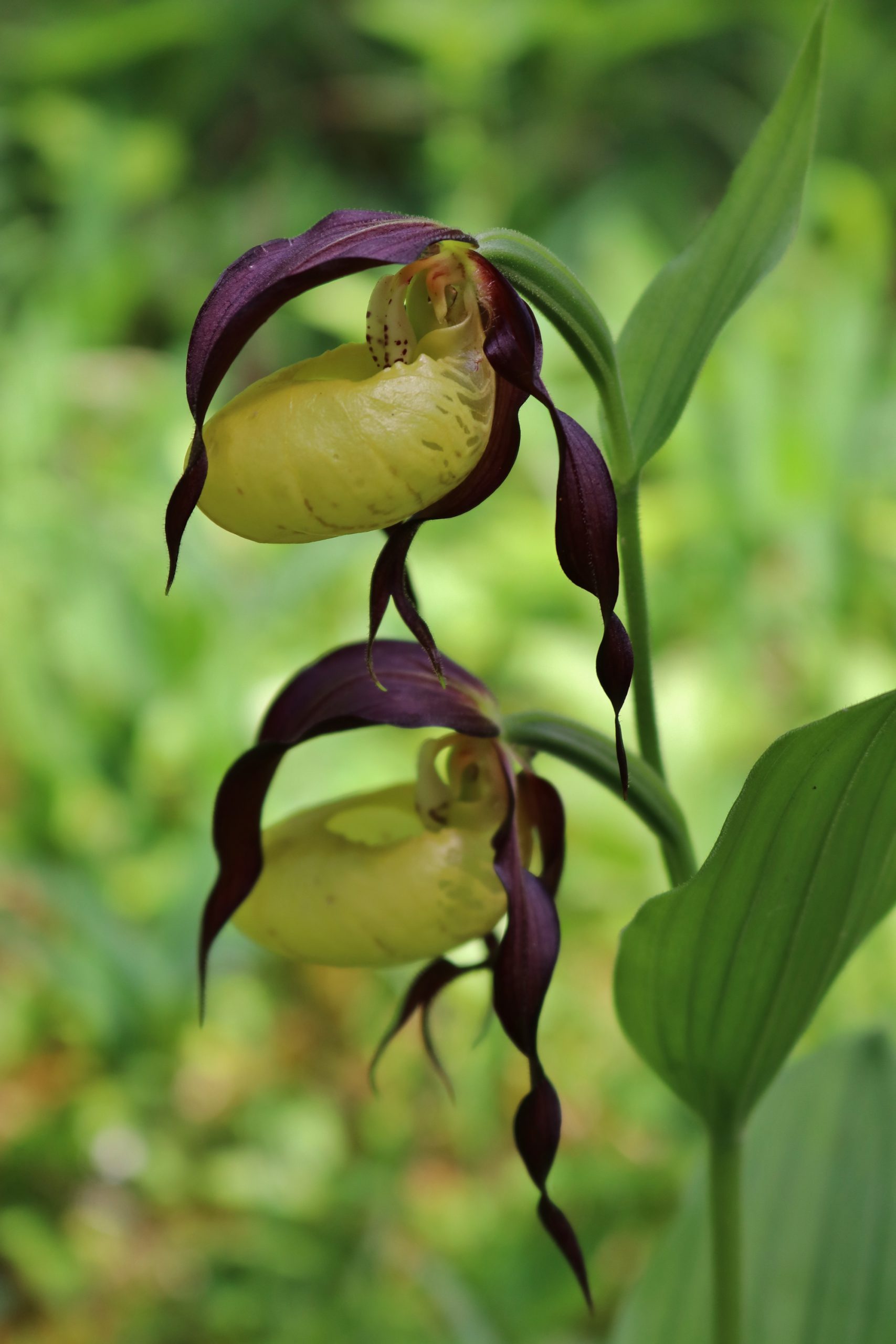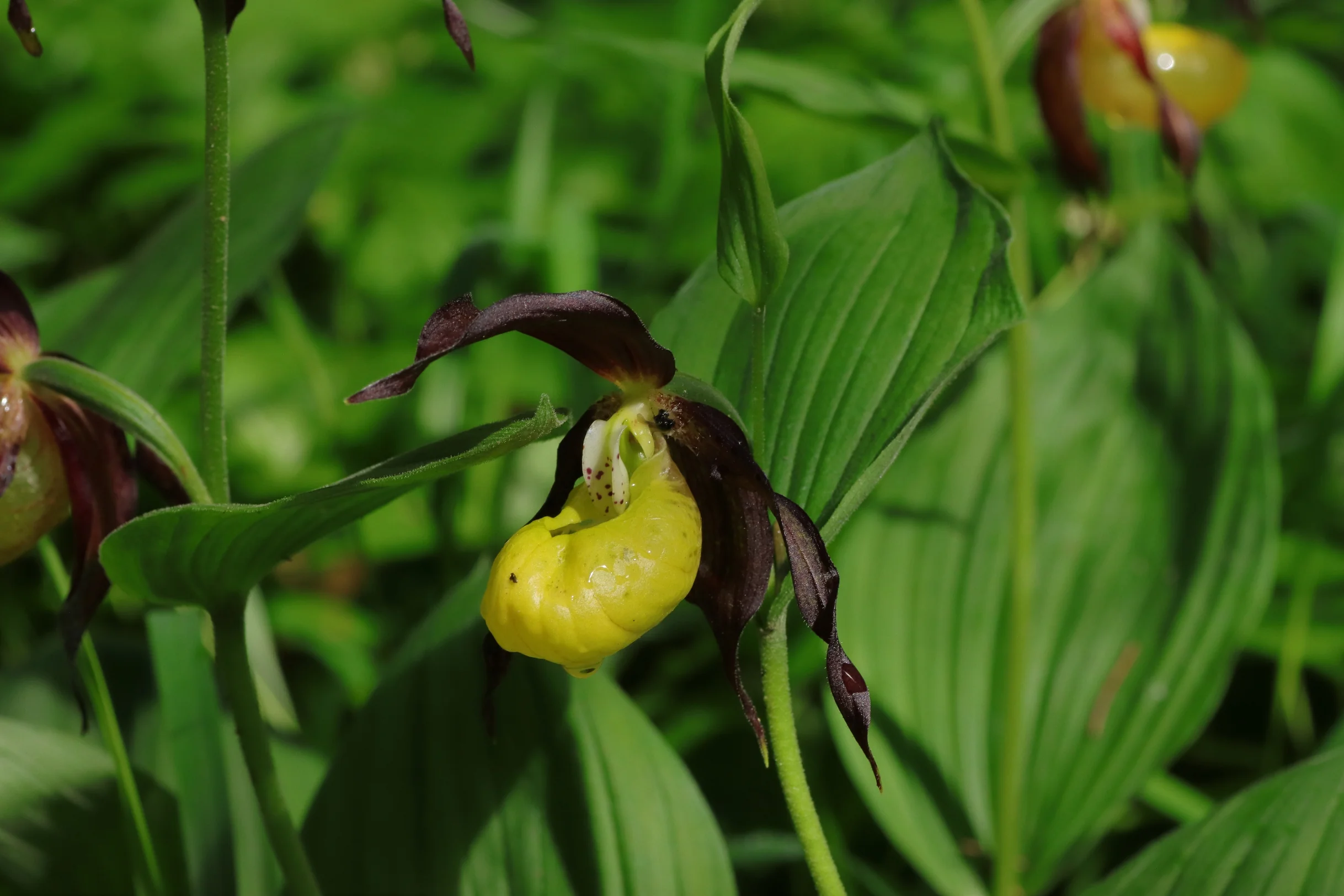One of the most beautiful and strictly protected native orchids of europe: the „lady’s-slipper orchid” (Cypripedium calceolus).



Occurrence and distribution: The lady’s-slipper orchid only grows in sparse, herb-rich deciduous and coniferous forests. The plant also requires a very special microclimate and soil conditions. In many places this native orchid is unfortunately already considered extinct. However, the specifics of the microclimate have not yet been fully explored. Therefore, attempts at re-breeding have failed so far. Digging up plants should also be refrained from, because these orchids do not tolerate the change to the garden climate. Therefore, they would not continue to grow in the garden for very long. However, more undemanding hybrids can be bought in garden stores!
Plant description
Growth habit & stems: The herbaceous, perennial plant reaches a height of between 15 and 60 cm. The stems are rounded and covered with short hairs. The flowers are at the end of the slightly bent stems. One to two (in rare cases three to four) flowers can form per stem. It is the largest of the native orchids (family Orchidaceae). An elongated, horizontally growing rhizome forms underground – these also serve as rhizomes / overwintering organs.
Leaves: Three to five leaves form per stem. The individual leaves are ovate to oblong-lanceolate in shape and can reach a length of up to 13 cm. These completely enclose the stem. The leaves have a green colouring. The leaf veins are clearly visible on the upper and lower sides.
Flowers: The flowers have chocolate brown or purple coloured perigone leaves with a bright yellow shoe-shaped lower lip. The perigone leaves are often rotated one to several times around their own axis. Inside the flower the plant has two stamens. These orchids have only a very limited small window of about 2 to 3 weeks flowering time per flower. The flowers do not offer nectar to pollinators. Pollination is carried out in particular by sand bees. They flower almost exclusively in the months of May and June.
Fruits: After pollination of the flower, the fruit clusters form – but pollination of the plant rarely occurs. The individual seed stalks are on long stems. They can reach up to 5 cm in length and 1 cm thick. Fruit ripening takes four months.
Special characteristics of the plant
Special features of the roots: At the end of the flowering period, the buds for the next year already develop from the roots. These overwinter underground and sprout in the spring of the following year. The lady’s-slipper orchid has a symbiotic relationship with a fungus of the genus “Rhizoctonia”. This provides the plant with nutrients until it produces leaves for the first time after 4 years. Only after up to 16 years can the first flowers be formed.
Special features of the flowers: The inflated lower lip serves as an “insect trap”. This is to ensure pollination of the flowers, as the insects are only released from them after pollination has taken place. The flowers emit an apricot-like scent and thus attract insects. The inside of the lower lip is covered with an oil and thus prevents the bees from climbing out. Underneath the stigma is a kind of “hair staircase” which is the only way out of the flower. First the stigma is touched and then the sticky pollen. This prevents self-pollination of the lady’s-slipper orchid. When visiting the next flower, pollination is carried out in this way.
Special features of the plant: Larger plant groups can form through the rhizome. These can reach a presumed age of 110 to 350 years (according to model calculations by Kull / 1999).
Name origin
Origin of name: The botanical name “Cypripedium” is derived from the Greek word “Κύπϱος” (Kypris) – the Greek epithet of Aphrodite (goddess of beauty and love) or Venus (Roman interpretation of Aphrodite) – and the Greek word “πέδιον” (pedion).
The word “Κύπϱος” can be translated as “the Cypriot / the Cyprus-born” and is an epithet for the goddess Aphrodite. The word “πέδιον” is considered a diminutive of shoe. A possible derivation is found in the Latin word “pes” = foot or also “pedis” = of the foot or the Greek word “podion” = little foot. Another possibility could be an incorrect translation of Latin / Greek words. Therefore the name can probably be translated into English as “little shoe of Aphrodite”. The botanical species name calceolus can be seen as a diminutive form of “calceus” – a typical Roman footwear.
Poisonousness of the plant
Poisonousness of the plant: All plant parts of the lady’s-slipper orchid are possibly slightly poisonous, like any other orchid species. Particular care should be taken with small children and pets. It may also cause mild skin irritation in some people.
Endangerment of the plant
Endangerment of the plant: On the Red List of Germany, the plant is already classified as endangered. It is already under the protection of the Bundesartenschutzverordnung, the special protection of the EU (Fauna-Flora-Habitat Directive) & the Washington Convention on International Trade in Endangered Species (CITES). They should not be dug up or picked off under any circumstances. The individual endangerment levels are as follows,
– Germany: endangered (Status: 3)
– Baden-Württemberg: endangered (status: 3)
– Bavaria: endangered (status: 3)
– Brandenburg: In danger of extinction (status: 1)
– Hesse: critically endangered (status: 2)
– Lower Saxony (hills, mountains): critically endangered (status: 2)
– Lower Saxony (lowland):extinct (status: 0)
North Rhine-Westphalia: critically endangered (status: 2)
Rhineland-Palatinate: In danger of extinction (status: 1)
Saxony: In danger of extinction (status: 1)
Saxony-Anhalt: critically endangered (status: 2)
Thuringia: critically endangered (status: 2)
Distribution codes: A, AV, M1, M2, (F), K